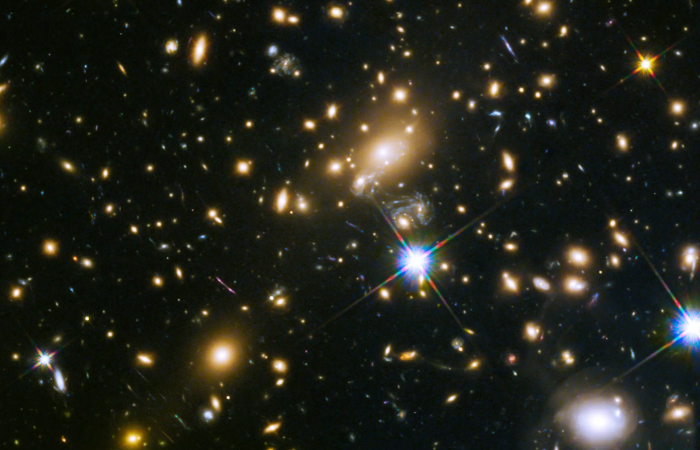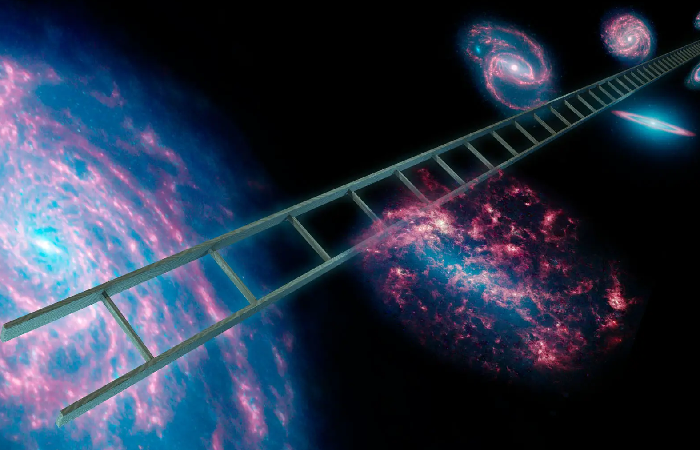Beyond Hubble: Unraveling the Secrets of Cosmic Expansion

A team led by researchers at the University of Minnesota Twin Cities developed a first-of-its-kind method to measure the rate of the universe's expansion, revealing information that might be used to more precisely estimate the age of the universe and further our understanding of the cosmos.
What Is Cosmic Expansion?
The concept known as cosmic expansion describes how the cosmos is growing significantly. It is among the most important discoveries of contemporary cosmology.
-
Two instances of evidence for this are the cosmic microwave background radiation and the redshift of light from far-off galaxies.
-
The cosmos' expansion is an example of how the general relativity theory predicts that the fabric of space can either stretch or contract.
-
The analogy of an expanding balloon is frequently used to illustrate the idea of cosmic expansion. As the balloon expands, all points on its surface move apart from one another.
-
Similar to how galaxies and other things throughout the cosmos move away from one another as it expands.
-
The measured redshift of light from distant objects is an essential result of cosmic expansion.
-
Light's wavelengths are stretched as the universe grows, which causes them to move towards longer, redder wavelengths.
-
Galaxies' spectra may be used to measure this redshift, and it shows that the galaxies are accelerating their motion away from the solar system.

Unraveling the Secrets of Cosmic Expansion
A team led by researchers from the University of Minnesota Twin Cities has successfully employed a first-of-its-kind technique to quantify the rate of expansion of the Universe using data from a magnified, multiply-imaged supernova.
-
Their findings provide light on a contentious issue in science and may aid in more precise dating of the universe and improved comprehension of the cosmos.
-
The work is separated into two publications, each of which was published in a peer-reviewed astronomy and astrophysics journal, The Astrophysical Journal, and Science, one of the top academic journals in the world.
-
There are two exact measures of the universe's expansion, or "Hubble constant," in astronomy. One is based on supernovae observed close by, while the other uses the "cosmic microwave background," or radiation that started to flow freely through the Universe shortly after the Big Bang.
-
But the disparity between these two measurements—roughly 10%—has sparked intense discussion among physicists and astronomers. The existing scientific understanding regarding the composition of the cosmos is incomplete if both readings are right.
According to Patrick Kelly, the lead author of both papers and an assistant professor at the University of Minnesota School of Physics and Astronomy, "it would become a chink in the armour of our understanding of the cosmos if new, independent measurements confirm this disagreement between the two measurements of the Hubble constant.
- The main query is if there might be a problem with any or both of the measures. In order to address this, our study measures the rate of universe expansion in a totally separate manner.

-
The first instance of a multiply-imaged supernova, which means that the telescope acquired four different photographs of the same cosmic event, was discovered by Kelly in 2014.
-
The team, lead by the University of Minnesota, was able to determine this value using data from this supernova. The supernova was predicted to resurface in 2015 at a different location by teams from all across the world after its discovery, and the University of Minnesota team discovered this extra image.
-
Because the explosion was gravitationally lensed by a galaxy cluster, a phenomenon in which material from the cluster bends and magnifies light, numerous images of the object appeared.
-
The researchers used a theory devised in 1964 by Norwegian astronomer Sjur Refsdal, which had previously been impractical to use, to determine the Hubble Constant by taking advantage of the temporal gaps between the appearances of the 2014 and 2015 photos.
-
According to Kelly, the research's conclusions don't definitively settle the argument, but they do offer deeper understanding of the issue and get scientists one step closer to attaining the most precise estimate of the Universe's age.
-
Although given the uncertainties, Kelly noted that "our measurement is in better agreement with the value from the cosmic microwave background," adding that "it does not rule out the measurement from the local distance ladder.
-
A problem with the present supernova value or our knowledge of galaxy-cluster dark matter would be revealed if measurements of future supernovae that are likewise gravitationally lensed by clusters produce a similar outcome.
-
The researchers discovered that several current galaxy-cluster dark matter models may adequately account for their observations of the supernovae using the same data.
This allowed scientists to answer a long-standing puzzle for astronomers: where does dark matter reside in the galaxy cluster? They were able to determine the most precise theories for this.

What Is Cosmic Value?
The term "cosmic value" may refer to the intrinsic or inherent value connected to the cosmos, the universe, or the natural world in general. It could imply the significance or value placed on the universe's size, intricacy, and beauty.
"Cosmic value" can also be used in a metaphysical or spiritual sense to describe the transcendent or spiritual meaning that individuals may attribute to the cosmos or their existence within it.
It's critical to keep in mind that "cosmic value" might have several interpretations based on the context in which it is employed as well as from person to person.
About Cosmic Values
In a wide sense, the term "cosmic values" may refer to a system of values that are in line with the greater cosmic or universal order. It might imply an outlook that considers the interconnection of all things, the harmony of the cosmos, or a respect for the natural environment.
Cosmic values in a spiritual or philosophical setting could include concepts like empathy, oneness, respect for life, and an understanding of our role in the universe' grandeur. It might stress the significance of encouraging wellbeing, living in peace with nature, and pursuing a better comprehension of life's mysteries.
Refrences
-
"The reappearance of Supernova Refsdal and its implications on the Hubble constant" is a scientific paper authored by a team of esteemed researchers, including Patrick L. Kelly, Steven Rodney, Tommaso Treu, Masamune Oguri, Wenlei Chen, Adi Zitrin, Simon Birrer, Vivien Bonvin, Luc Dessart, Jose M. Diego, Alexei V. Filippenko, Ryan J. Foley, Daniel Gilman, Jens Hjorth, Mathilde Jauzac, Kaisey Mandel, Martin Millon, Justin Pierel, Keren Sharon, Stephen Thorp, Liliya Williams, Tom Broadhurst, Alan Dressler, Or Graur, Saurabh Jha, Curtis McCully, Marc Postman, Kasper Borello Schmidt, Brad E. Tucker, and Anja von der Linden.
-
The publication date is May 11, 2023, and it was published in the journal Science with the DOI: 10.1126/science.abh1322.
-
Another relevant paper, "Time Delay and Magnification Measurements of the Splendid Five Images of Supernova Refsdal," authored by Patrick L. Kelly, Steven Rodney, Tommaso Treu, Simon Birrer, Vivien Bonvin, Luc Dessart, Ryan J. Foley, Alexei V. Filippenko, Daniel Gilman, Saurabh Jha, Jens Hjorth, Kaisey Mandel, Martin Millon, Justin Pierel, Stephen Thorp, Adi Zitrin, Tom Broadhurst, Wenlei Chen, Jose M. Diego, Alan Dressler, Or Graur, Mathilde Jauzac, Matthew A. Malkan, Curtis McCully, Masamune Oguri, Marc Postman, Kasper Borello Schmidt, Keren Sharon, Brad E. Tucker, Anja von der Linden, and Joachim Wambsganss, was published on the same date in The Astrophysical Journal. Its DOI is 10.3847/1538-4357/ac4ccb.
-
This groundbreaking research received primary funding from NASA through the Space Telescope Science Institute, as well as support from the National Science Foundation.
-
In addition to Patrick L. Kelly, the research team comprised scholars from various esteemed institutions such as the Minnesota Institute for Astrophysics at the University of Minnesota, the University of South Carolina, the University of California, Los Angeles, Stanford University, the Swiss Federal Institute of Technology Lausanne, Sorbonne University, the University of California, Berkeley, the University of Toronto, Rutgers University, the University of Copenhagen, the University of Cambridge, the Kavli Institute for Cosmology, Ben-Gurion University of the Negev, the University of the Basque Country, the University of Cantabria, Consejo Superior de Investigaciones Cientificas (the Spanish National Research Council), the Observatories of the Carnegie Institution for Science, the University of Portsmouth, Durham University, the University of California, Santa Barbara, the University of Tokyo, the Space Telescope Science Institute, the Leibniz Institute for Astrophysics Potsdam, the University of Michigan, Australian National University, Stony Brook University, Heidelberg University, and Chiba University.




